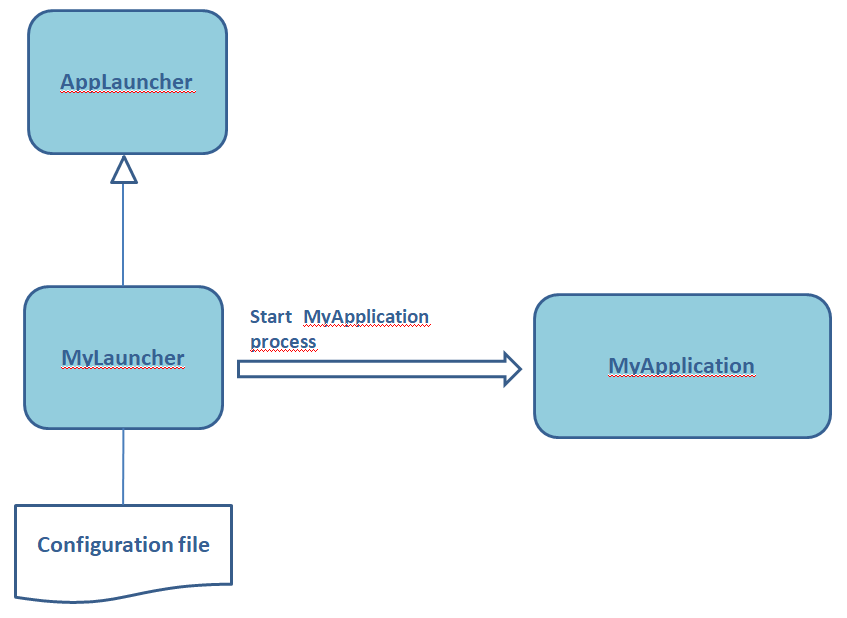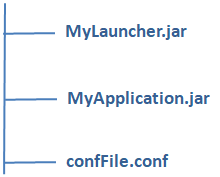AppLauncher
1 Overview
2 Extend the AppLauncher class
2.1 Mandatory methods
2.2 Optional methods
2.2.1 Specify the module paths
2.2.2 Specify the --add-opens declarations
2.2.3 Specify the --add-exports declarations
2.2.4 Specify the required Java version
2.2.5 Specify the allowed custom properties
2.2.6 Specify the main Class
3 Specify the path of the configuration file as an argument
4 Configuration file properties
4.1 JAVAHOME property
4.2 JAVAFXLIB property
4.3 MODULEPATH property
4.4 LIBPATH property
4.5 VMARGS property
4.6 REQUIRE_VERSION property
4.7 Environment variables properties
4.8 Custom property
5 Start the application
6 Handle errors
7 Notes
8 See also
2 Extend the AppLauncher class
2.1 Mandatory methods
2.2 Optional methods
2.2.1 Specify the module paths
2.2.2 Specify the --add-opens declarations
2.2.3 Specify the --add-exports declarations
2.2.4 Specify the required Java version
2.2.5 Specify the allowed custom properties
2.2.6 Specify the main Class
3 Specify the path of the configuration file as an argument
4 Configuration file properties
4.1 JAVAHOME property
4.2 JAVAFXLIB property
4.3 MODULEPATH property
4.4 LIBPATH property
4.5 VMARGS property
4.6 REQUIRE_VERSION property
4.7 Environment variables properties
4.8 Custom property
5 Start the application
6 Handle errors
7 Notes
8 See also
The AppLauncher class launch a process to start a Java jar file.
The supported arguments are:
The class allows to start a new process with a specified JVM (not necessarily the current JVM used to execute the

To extend the AppLauncher class, you need to implement the two following methods:
For example, suppose that you want to start the

The code of the
For example:
For example:
For example:
The AppLauncher.separateCustomArguments(boolean) specifies how the custiom properties names and values are handled in the arguments:
For example:
The AppLauncher.getConfigurationFile() method return the name of the configuration file which will be used to configure the application. This file must be in the same directory as the jar file which contains the launcher class.
It is also possible to allow the user to specify the path of the file by using the
For example:
For example:
For example:
For example:
For example:
For example:
The supported arguments are:
- The location of the JavaFX libraries if they are required
- The libraries path
- The module paths (the
--add-modulesdeclarations) - The
--add-opensdeclarations - The
--add-exportsdeclarations - The required Java version
- Environment variables
- Specific additional VM arguments
Overview
Main Article: AppLauncher use cases
The class allows to start a new process with a specified JVM (not necessarily the current JVM used to execute the
AppLauncher program) with customized arguments specified in a configuration file:
Extend the AppLauncher class
Mandatory methods
To extend the AppLauncher class, you need to implement the two following methods:
- The AppLauncher.getLaunchable() method must return the name of the jar file which contains the application to start. Note that this file must be in the same directory as the jar file which contains the launcher class
- The AppLauncher.getConfigurationFile() method must return the name of the configuration file which will be used to configure the application. This file must also be in the same directory as the jar file which contains the
AppLauncherclass
main(String[]) method to create the launcher and call the AppLauncher.start() method which will start your application in a child process.For example, suppose that you want to start the
MyApplication.jar application with the MyAppLauncher.jar launcher. The file structure must be:
The code of the
MyAppLauncher.jar class should be:public class MyAppLauncher extends AppLauncher { public AppLauncher(String[] args) { super(args); } public static void main(String[] args) { MyAppLauncher launcher = new MyAppLauncher(args); launcher.start(); } @Override protected String getLaunchable() { return "MyApplication.jar"; } @Override protected String getConfigurationFile() { return "confFile.conf"; } }
Optional methods
Several optional methods allow to:- Specify the module paths (the
--add-modulesdeclaration) - Specify the
--add-opensdeclarations - Specify the
--add-exportsdeclarations - Specify the required Java version
- Specify the allowed custom properties
- Specify the path of the main Class
Specify the module paths
The AppLauncher.setAddModules(String) method allows to set the--add-modules declaration[1]
See dev.java for more information
.For example:
launcher.setAddModules("javafx.controls,javafx.fxml,javafx.graphics,javafx.swing,javafx.web");
Specify the --add-opens declarations
The AppLauncher.setAddOpensAllUnnamed(String...) method allows to set the---add-opens declarations with an ALL-UNNAMED value[2]
See dev.java for more information
.For example:
launcher.setAddOpensAllUnnamed("javafx.web/javafx.scene.web", "javafx.web/com.sun.webkit");
Specify the --add-exports declarations
The AppLauncher.setAddExportsAllUnnamed(String...) method allows to set the---add-exports declarations with an ALL-UNNAMED value[3]
See dev.java for more information
. For example:
launcher.setAddExportsAllUnnamed("javafx.web/javafx.scene.web", "javafx.web/com.sun.webkit");
Specify the required Java version
The AppLauncher.requireJavaVersion(String) method allows to specify a required JVM major version to execute your program. There are several ways to declare the version:- If the argument has the
{number}pattern, then the associated major version is required - If the argument has the
{number}-pattern, then the major version must be greater or equal to the associated number - If the argument has the
-{number}pattern, then the major version must be smaller or equal to the associated number - If the argument has the
{number}-{number}pattern, then the major version must be between the two associated numbers
launcher.requireJavaVersion("11"); the major version must be 11 launcher.requireJavaVersion("11-"); the major version must be 11 or more launcher.requireJavaVersion("-11"); the major version must be 11 or less launcher.requireJavaVersion("9-11"); the major version must be between 9 and 11
Specify the allowed custom properties
The AppLauncher.getCustomProperties() method returns the allowed set of custom properties names, which will be used in the configuration properties file. ByThe AppLauncher.separateCustomArguments(boolean) specifies how the custiom properties names and values are handled in the arguments:
- By default the key and the values are concatenated with a "=" sign
- If the parameter of the
"separateCustomArgumentsmethod is true, then the key and value will be on two separate arguments
- By default
myKey=myValuein the configuration file will create in the argumentsmyKey=myValue - With the
truevalue for the methodmyKey=myValuein the configuration file will create in the argumentsmyKey myValue
Specify the main Class
The AppLauncher.setMainClass(String) method allows to specify the path of the main Class to use when starting the application.For example:
launcher.setMainClass("my.main.MyApplication");
Specify the path of the configuration file as an argument
Main Article: Mandatory methods
The AppLauncher.getConfigurationFile() method return the name of the configuration file which will be used to configure the application. This file must be in the same directory as the jar file which contains the launcher class.
It is also possible to allow the user to specify the path of the file by using the
-appLauncher.conf=>path> argument when you start the launcher. The path can be absolute or relative to the directory of the launcher.For example:
java -jar AppLauncher.jar -appLauncher.conf=myConfigFile.conf
If the path is empty, a file chooser will ask the user to select the file. For example:
java -jar AppLauncher.jar -appLauncher.conf=
Configuration file properties
The file properties has several properties which allows to:-
JAVAHOME: Specifies the location of the JVM to use for the application to launch -
JAVAFXLIB: Specifies the location of the JavaFX libraries for use to the application to launch -
MODULEPATH: Specifies the "--module-path" argument. This is an alternate way of setting the "--module-path" through the API (see Specify the module paths) -
LIBPATH: Specifies the "java.library.path" argument -
VMARGS: Specifies additional VM arguments to use -
REQUIRE_VERSION: Specifies the required JVM version. This is an alternate way of setting it through the API (see Specify the required Java version) -
ENV:<environment variable name>: environment variables that you want to set for the application process - Custom properties: all properties with names different from the previous ones
JAVAHOME property
TheJAVAHOME property specifies the location of the JVM to use for the application to launch. For example:
JAVAHOME=L:\WRK\Java\Tools\jdk-17.0.2
JAVAFXLIB property
TheJAVAFXLIB property specifies the location of the JavaFX libraries for use to the application to launch. For example:
JAVAFXLIB=L:\WRK\Java\Tools\javafx17\lib
MODULEPATH property
TheMODULEPATH property specifies the "--module-path" argument. This is an alternate way of setting the "--module-path" through the API (see Specify the module paths). For example:
MODULEPATH=javafx.controls,javafx.fxml,javafx.graphics,javafx.swing,javafx.web
LIBPATH property
TheLIBPATH property specifies the java.library.path argument.
VMARGS property
TheVMARGS property additional VM arguments to use. The arguments must be separated by spaces.
REQUIRE_VERSION property
TheREQUIRE_VERSION property specifies the required JVM version. This is an alternate way of setting it through the API (see Specify the required Java version).
Environment variables properties
TheENV:<environment variable name> properties specify environment variables that you want to set for the application process.For example:
ENV:HOMEPAGE=http://my.homepage.html
Custom property
All properties with names different from the previous ones are custom properties and will be added in the arguments (for those which names are allowed).For example:
JAVAHOME=L:\WRK\Java\Tools\jdk-17.0.2 myKey=myValue
Start the application
The AppLauncher.start() method creates a process to start the application.Handle errors
By default errors will throw a AppLauncherException. The kinds of errors are:- The AppLauncher.getLaunchable() method returns null
- The AppLauncher.getConfigurationFile() method returns null
- The launchable does not exist
- The configuration file does not exist
- The JVM is not compatible with the required version
- The executable could not be launched
- AppLauncher.MESSAGE_ERRORS shows an error message
- AppLauncher.POPUP_ERRORS shows an popup error window
Notes
See also
- AppLauncher use cases: This article is about the AppLauncher class use cases
×
![]()
Categories: Lang.applauncher | Packages